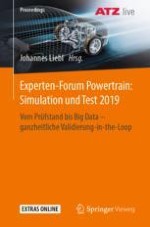Abstract
Nowadays 0D/1D simulations are being widely used in the engine development process. Thanks to the high prediction quality of the models and the low computational times, they are powerful tools to investigate engine and powertrain concepts for the years 2030+.
Nearly all SI-powertrains will have at least a 48 V hybridization in 2030+. As the electric drivetrain will be active above all in the low-load range, typical part-load efficiency measures will become less relevant, whereas efficiency improvements in the area of 40–80% load will become crucial. Hence, new concepts are needed to guarantee the efficient SI-engine operation in a very wide range of engine operating conditions. In this context, technologies such as lean engine operation, high load EGR or long stroke engines emerge as new, challenging tasks in the 0D/1D simulation.
In order to achieve high model prediction accuracy, 0D/1D models used for the simulation of future SI engine concepts do not only have to consider thermodynamic effects, but also need to account for the in-cylinder chemical processes in detail. Kinetic reaction mechanisms for different fuel types that have been intensively developed in the recent years can be used to perform simulations at in-cylinder conditions that provide better understanding of the chemical processes during the combustion. More importantly, they enable the development and validation of simplified approaches for the 0D/1D simulation that reproduce the real chemistry behavior very accurately.
In this way, correlations yielding exact values for the laminar flame speed of different fuels have been developed at FKFS, making the reliable predictive simulation of lean combustion possible. A CCV model can then be used to estimate the possible engine operation region and the changes in fuel consumption resulting from the cycle-to-cycle variations. Furthermore, the reaction kinetics simulations at in-cylinder conditions proved that, at specific boundary conditions, the auto-ignition of the unburnt mixture resulting in knock happens in two stages. This phenomenon significantly influences the ignition delay of the mixture and characterizes gasoline fuels. Based on these findings, a new knock modeling approach was developed.
For SI-engine concepts based on mixture dilution in the years 2030+, one of the most important challenges will be the management of the exhaust gas temperature during RDE to avoid light-out of exhaust aftertreatment components. The expected increase in the engine’s thermal efficiency will lower the exhaust gas temperatures, making the aftertreatment components even more prone to light-out. It is thus crucial for future engine concepts to simulate this behavior in RDE situations correctly, which is a challenging task for a 1D simulation. The combination of a 1D flow path model and a quasi-dimensional burn rate model leads either to inacceptable simulation times or to very inaccurate results. A new approach introduced by FKFS and Bosch in June 2018 with a combination of a physics-based modelling of the gas exchange and a data-based model of the high-pressure part, aiming to resolve this dilemma, will be discussed in this context.
